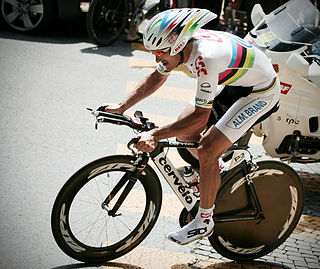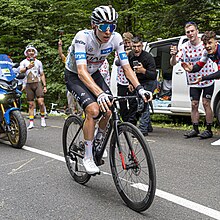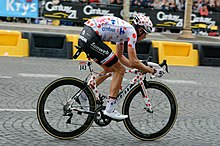
The 2002 Tour de France was a multiple-stage bicycle race held from 6 to 28 July, and the 89th edition of the Tour de France. The event started in Luxembourg and ended in Paris. The Tour circled France counter-clockwise, visiting the Pyrenees before the Alps. It has no overall winner—although American cyclist Lance Armstrong originally won the event, the United States Anti-Doping Agency announced in August 2012 that they had disqualified Armstrong from all his results since 1998, including his seven Tour de France wins from 1999 to 2005; the Union Cycliste Internationale confirmed the result.
The Vuelta a España is an annual multi-stage bicycle race primarily held in Spain, while also occasionally making passes through nearby countries. Inspired by the success of the Tour de France and the Giro d'Italia, the race was first organised in 1935. The race was prevented from being run by the Spanish Civil War and World War II in the early years of its existence; however, the race has been held annually since 1955. As the Vuelta gained prestige and popularity the race was lengthened and its reach began to extend all around the globe. Since 1979, the event has been staged and managed by Unipublic, until in 2014, when the Amaury Sport Organisation acquired control. Since then, they have been working together. The peloton expanded from a primarily Spanish participation to include riders from all over the world. The Vuelta is a UCI World Tour event, which means that the teams that compete in the race are mostly UCI WorldTeams, with the exception of the wild card teams that the organizers can invite.

An individual time trial (ITT) is a road bicycle race in which cyclists race alone against the clock. There are also track-based time trials where riders compete in velodromes, and team time trials (TTT). ITTs are also referred to as "the race of truth", as winning depends only on each rider's strength and endurance, and not on help provided by teammates and others riding ahead and creating a slipstream. Individual time trial are usually held on flat or rolling terrain, although sometimes they are held up a mountain road. Sometimes the opening stage of a stage race is a very short individual time trial called a prologue.

A touring bicycle is a bicycle designed or modified to handle bicycle touring. To make the bikes sufficiently robust, comfortable and capable of carrying heavy loads, special features may include a long wheelbase, frame materials that favor flexibility over rigidity, heavy duty wheels, and multiple mounting points.

The 2004 Tour de France was the 91st edition of Tour de France, one of cycling's Grand Tours. The Tour began in Liège, Belgium with a prologue individual time trial on 3 July and Stage 10 occurred on 14 July with a hilly stage from Limoges. The race finished on the Champs-Élysées in Paris on 25 July.

A sprinter is a road bicycle racer or track racer who can finish a race very explosively by accelerating quickly to a high speed, often using the slipstream of another cyclist or group of cyclists tactically to conserve energy.

A time trialist is a road bicycle racer who can maintain high speeds for long periods of time, to maximize performance during individual or team time trials. The term cronoman, or chronoman, is also used to refer to a time trialist.

Laurent Jalabert is a French former professional road racing cyclist, from 1989 to 2002.

The 1998 Tour de France was the 85th edition of the Tour de France, one of cycling's Grand Tours. The 3,875 km (2,408 mi) race was composed of 21 stages and a prologue. It started on 11 July in Ireland before taking an anti-clockwise route through France to finish in Paris on 2 August. Marco Pantani of Mercatone Uno–Bianchi won the overall general classification, with Team Telekom's Jan Ullrich, the defending champion, and Cofidis rider Bobby Julich finishing on the podium in second and third respectively.

The mountains classification is a secondary competition in the Tour de France, that started in 1933. It is given to the rider that gains the most points for reaching mountain summits first. The leader of the classification is named the King of the Mountains, and since 1975 wears the polka dot jersey, a white jersey with red polka dots.

Road bicycle racing is the cycle sport discipline of road cycling, held primarily on paved roads. Road racing is the most popular professional form of bicycle racing, in terms of numbers of competitors, events and spectators. The two most common competition formats are mass start events, where riders start simultaneously and race to a set finish point; and time trials, where individual riders or teams race a course alone against the clock. Stage races or "tours" take multiple days, and consist of several mass-start or time-trial stages ridden consecutively.

The 1905 Tour de France was the third edition of the Tour de France, held from 9 to 30 July, organised by the newspaper L'Auto. Following the disqualifications after the 1904 Tour de France, there were changes in the rules, the most important one being the general classification not made by time but by points. The race saw the introduction of mountains in the Tour de France, and René Pottier excelled in the first mountain, although he could not finish the race. Due in part to some of the rule changes, the 1905 Tour de France had less cheating and sabotage than in previous years, though they were not completely eliminated. It was won by Louis Trousselier, who also won four of the eleven stages.

This is a glossary of terms and jargon used in cycling, mountain biking, and cycle sport.

Bicycle gearing is the aspect of a bicycle drivetrain that determines the relation between the cadence, the rate at which the rider pedals, and the rate at which the drive wheel turns.

Bicycle performance is measurable performance such as energy efficiency that affect how effective a bicycle is. Bicycles are extraordinarily efficient machines; in terms of the amount of energy a person must expend to travel a given distance, cycling is calculated to be the most efficient self-powered means of transportation.

The 1963 Tour de France was the 50th instance of that Grand Tour. It took place between 23 June and 14 July, with 21 stages covering a distance of 4,138 km (2,571 mi). Stages 2 and 6 were both two part stages, the first half being a regular stage and the second half being a team or individual time trial.
VAM is the abbreviation for the Italian term velocità ascensionale media, translated in English to mean "average ascent speed" or "mean ascent velocity", but usually referred to as VAM. It is also referred to by the English backronym "Vertical Ascent in Meters". The term, which was coined by Italian physician and cycling coach Michele Ferrari, is the speed of elevation gain, usually stated in units of metres per hour.

Christopher Clive Froome [kɹɪs fɹuːm], is a Kenyan-British professional road racing cyclist who currently rides for UCI ProTeam Israel–Premier Tech. He has won seven Grand Tours: four editions of the Tour de France, one Giro d'Italia (2018) and the Vuelta a España twice. He has also won several other stage races, and the Vélo d'Or three times. Froome has also won two Olympic bronze medals in road time trials, in 2012 and 2016, and took bronze in the 2017 World Championships.

The 2011 Vuelta a España was held from 20 August to 11 September. The bicycle race began in Benidorm with a team time trial and ended, as is traditional, in Madrid. The 2011 Vuelta was the 66th edition of the race and was the first Vuelta in 33 years that visited the Basque Country. The 33-year absence from the region was due to fear of political protests.

A puncheur or puncher is a road bicycle racer who specialises in rolling terrain with short but steep climbs.





















